Top 10 Foods Highest in Zinc
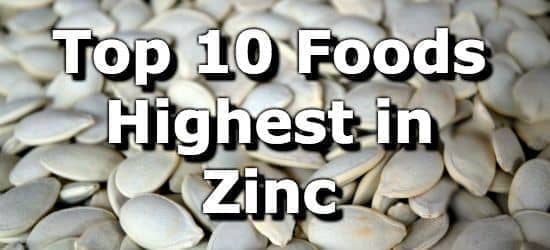
Zinc is an essential mineral found in over 300 enzymes. (1) Zinc is needed for wound healing, immune system function, building proteins and DNA, fertility in adults, and growth in children. (2,3) Zinc is also needed for maintaining the senses of smell and taste. (4)
A deficiency in zinc can lead to stunted growth, impotence, hair loss, eye and skin lesions, impaired appetite, and depressed immunity. (5)
Conversely, consuming too much zinc can lead to nausea, vomiting, loss of appetite, abdominal cramps, diarrhea, and headaches. High doses of zinc can also disrupt the absorption of iron and copper in the digestive tract. (6,7)
Foods high in zinc include oysters, beef, chicken, tofu, pork, nuts, seeds, lentils, yogurt, oatmeal, and mushrooms. The current daily value (DV) for zinc is 11mg. (8) This is a target intended for the general population, but some people may have different needs for zinc based on their age, gender, diet, or medical factors.
Below is a list of the top ten foods highest in zinc by common serving size, for more, see the lists of vegetarian zinc foods, high zinc vegetables, high zinc fruits, and high zinc nuts.
Top 10 High Zinc Foods
-
 1. Oysters + Add
1. Oysters + Add
Zinc
per 6 OystersZinc
per 100gZinc
per 200 Calories52mg
(472% DV)61mg
(555% DV)155mg
(1405% DV)Other Seafood High in Zinc
- 93% DV zinc in a king crab leg
- 47% DV in 20 small clams
- 47% DV in 1 cup of canned blue crab
- 31% DV in a 3oz serving of lobster
- 26% DV in a 3oz serving of octopus
See the full list of over 100 fish high in zinc.
-
 2. Beef (Chuck Steak) + Add
2. Beef (Chuck Steak) + Add
Zinc
per 5oz SteakZinc
per 100gZinc
per 200 Calories15mg
(140% DV)11mg
(99% DV)12mg
(105% DV)More Red Meat High in Zinc
- 129% DV zinc in a ribeye steak
- 60% DV in 3oz of a chuck beef roast
- 46% DV in a 3oz hamburger patty
- 41% DV in 3oz of ground buffalo
- 39% DV in a 3oz lamb shank
See the full list of meats high in zinc.
-
 3. Chicken Leg + Add
3. Chicken Leg + Add
Zinc
per Roasted Leg (Thigh And Leg)Zinc
per 100gZinc
per 200 Calories5mg
(49% DV)2mg
(19% DV)2mg
(20% DV)More Poultry High in Zinc
- 33% DV in 1 cup of roast duck
- 27% DV in 3oz of roast turkey
- 23% DV in a chicken drumstick (leg)
See the full list of meats high in zinc.
-
 4. Firm Tofu + Add
4. Firm Tofu + Add
Zinc
per CupZinc
per 100gZinc
per 200 Calories4mg
(36% DV)2mg
(14% DV)2mg
(20% DV)More Soy Products High in Zinc
- 48% DV in 1 cup of natto
- 15% DV in 1 cup of green soybeans
- 14% DV in 1 cup of tempeh
See over 60 beans and legumes high in zinc.
-
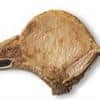 5. Lean Pork Chops + Add
5. Lean Pork Chops + Add
Zinc
in a 6oz ChopZinc
per 100gZinc
per 200 Calories4mg
(32% DV)2mg
(19% DV)2mg
(19% DV)More Pork Products High in Zinc
- 36% DV in 3oz of pork spare ribs
- 35% DV in a 3oz Boston steak
- 32% DV in 3oz of salami
- 25% DV in a Bratwurst Sausage
- 21% DV in 3oz of SPAM
See the full list of meats high in zinc.
-
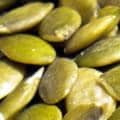 6. Squash and Pumpkin Seeds + Add
6. Squash and Pumpkin Seeds + Add
Zinc
per 1 Oz HandfulZinc
per 100gZinc
per 200 Calories3mg
(27% DV)10mg
(94% DV)5mg
(42% DV)More Nuts and Seeds High in Zinc
- 17% DV per oz of pine nuts
- 14% DV per oz of cashews
- 13% DV per oz of sunflower seeds
See the top 10 nuts and seeds high in zinc.
-
 7. Lentils + Add
7. Lentils + Add
Zinc
per CupZinc
per 100gZinc
per 200 Calories3mg
(23% DV)1mg
(12% DV)2mg
(20% DV)Beans High in Zinc
- 23% DV zinc in 1 cup of garbanzo beans (chickpeas)
- 22% DV in 1 cup of large white beans
- 20% DV in 1 cup of black-eyed peas
- 18% DV in 1 cup of navy beans
- 18% DV in 1 cup of black beans
See the full list of beans high in zinc.
-
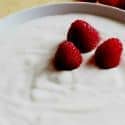 8. Low-Fat Yogurt + Add
8. Low-Fat Yogurt + Add
Zinc
per CupZinc
per 100gZinc
per 200 Calories2mg
(22% DV)1mg
(9% DV)3mg
(31% DV)More Dairy Foods High in Zinc
- 16%DV zinc per 16oz glass of milk
- 15% DV in 1/2 cup of low-fat ricotta
- 11% DV in a 1oz slice of Swiss cheese
- 11% DV in 1oz of grated parmesan
- 10% DV in 1oz of Gouda
See all dairy products high in zinc.
-
 9. Oatmeal + Add
9. Oatmeal + Add
Zinc
per CupZinc
per 100gZinc
per 200 Calories2mg
(21% DV)1mg
(9% DV)3mg
(26% DV)Fortified breakfast cereals can provide 170% DV zinc per serving, but are not necessarily a healthier choice, as some can be high in added sugar and salt.
-
 10. Shiitake Mushrooms + Add
10. Shiitake Mushrooms + Add
Zinc
per Cup CookedZinc
per 100gZinc
per 200 Calories2mg
(18% DV)1mg
(12% DV)5mg
(43% DV)More Vegetables High in Zinc
- 17% DV zinc in 1 cup of green peas
- 12% DV in 1 cup of cooked spinach
- 12% DV in 1 cup of lima beans
For more see the top 10 high zinc vegetables.
Printable One Page Sheet
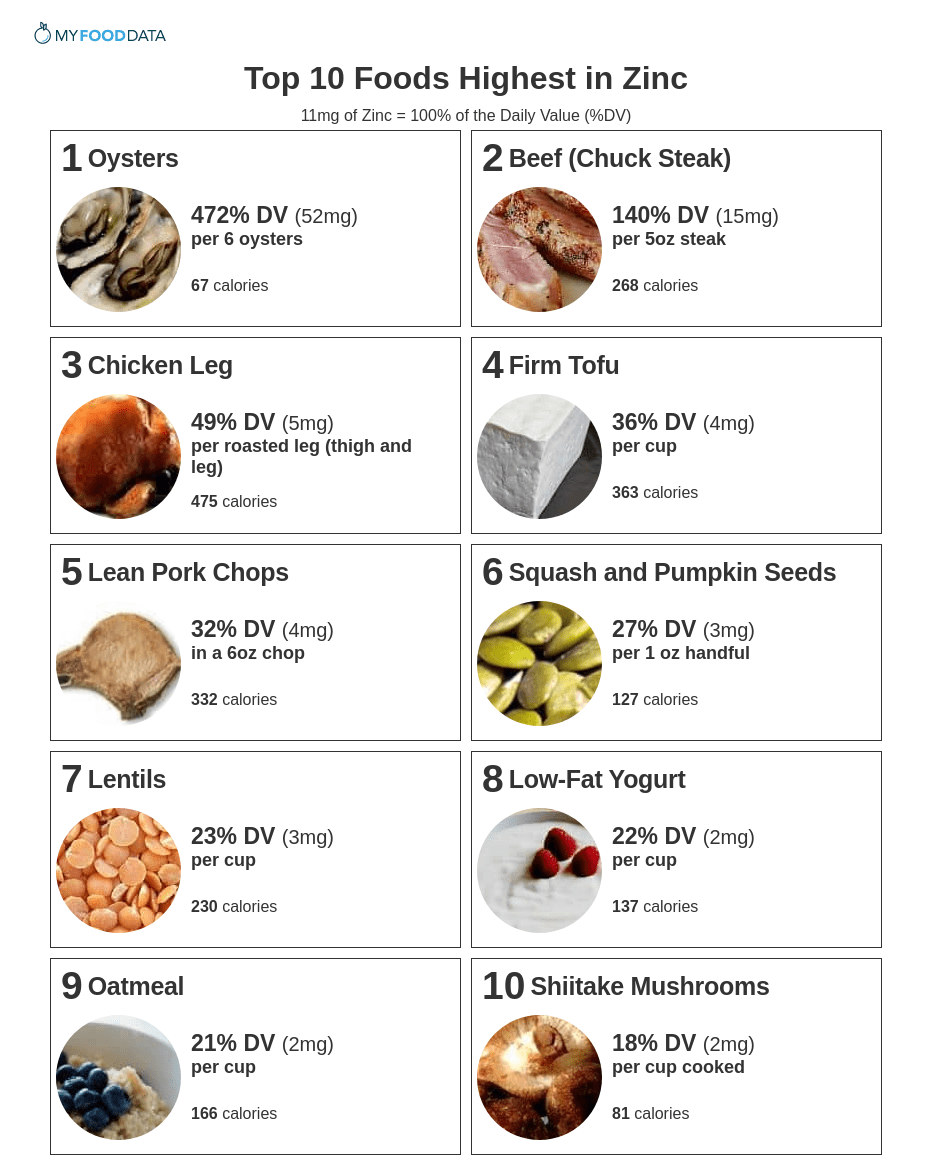
Zinc Requirements By Age and Gender
The recommended daily allowance (RDA) for zinc ranges from 3mg to 11mg per day, depending on a person's age and gender. The daily value for zinc is 11mg per day. (8) The daily value is a general guideline that will prevent deficiency for most people and is listed on food labels, while the RDA is specific for age and gender.
| Life Stage | RDA |
|---|---|
| Infants | |
| 0-6 months old* | 2mg |
| 7-12 months old | 3mg |
| Children | |
| 1-3 years old | 3mg |
| 4-8 years old | 5mg |
| Males | |
| 9-13 years old | 8mg |
| 14-18 years old | 11mg |
| 19-50 years old | 11mg |
| 50+ years old | 11mg |
| Females | |
| 9-13 years old | 8mg |
| 14-18 years old | 9mg |
| 19-50 years old | 8mg |
| 50+ years old | 8mg |
| Pregnancy | |
| 14-18 years old | 12mg |
| 18+ years old | 11mg |
| Lactation | |
| 14-18 years old | 13mg |
| 18+ years old | 12mg |
Source: Dietary Reference Intakes for Zinc.
From the Nutrient Ranking Tool
Use the ranking tool links below to select foods and create your own food list to share or print.
- Foods High in Zinc
- Foods Low in Zinc
- Vegetables High in Zinc
- Fruits High in Zinc
- Vegetarian Foods High in Zinc
- Nuts High in Zinc
- Grains High in Zinc
- Beans High in Zinc
- Dairy High in Zinc
- Breakfast Cereals High in Zinc
- Fast Foods High in Zinc
View more nutrients with the nutrient ranking tool, or see ratios with the nutrient ratio tool.
Related
Data Sources and References
- Zastrow ML, Pecoraro VL. Function and mechanism of zinc metalloenzymes Biochemistry. 2014 Feb 18;53(6):957-78. doi: 10.1021/bi4016617. Epub 2014 Feb 7. 24506795
- Rasouli M, Rahimi A, Soleimani M, Keshel SH. Zinc in Wound Healing Modulation Acta Histochem. 2021 Oct;123(7):151785. doi: 10.1016/j.acthis.2021.151785. Epub 2021 Sep 6. 34500185
- Haase H, Rink L. Zinc and the immune system Metallomics. 2014 Jul;6(7):1175-80. doi: 10.1039/c3mt00353a. 24531756
- Doty RL. Zinc and the special senses Handb Clin Neurol. 2019;164:229-246. doi: 10.1016/B978-0-444-63855-7.00015-0. 31604550
- Crider K, Williams J, Qi YP, Gutman J, Yeung L, Mai C, Finkelstain J, Mehta S, Pons-Duran C, Menéndez C, Moraleda C, Rogers L, Daniels K, Green P. Zinc Deficiency Cochrane Database Syst Rev. 2022 Feb 1;2(2022):CD014217. doi: 10.1002/14651858.CD014217. 36321557
- Crider K, Williams J, Qi YP, Gutman J, Yeung L, Mai C, Finkelstain J, Mehta S, Pons-Duran C, Menéndez C, Moraleda C, Rogers L, Daniels K, Green P. Zinc Toxicity Cochrane Database Syst Rev. 2022 Feb 1;2(2022):CD014217. doi: 10.1002/14651858.CD014217. 36321557
- Maret W, Sandstead HH. Zinc toxicity J Trace Elem Med Biol. 2006;20(1):3-18. doi: 10.1016/j.jtemb.2006.01.006. Epub 2006 Feb 21. 16632171
- U.S.FDA - Daily Value on the New Nutrition and Supplement Facts Labels
Simplify Nutrition Tracking with MyFoodData!
Speedy Tools and Detailed Data FREEEasily analyze your meals to find the best foods for your goals.
✅ Use our recipe nutrition calculator and nutrition comparison tool.
✅ Access expert nutrition data tools and in-depth articles.
✅ Log foods and organize your recipes with a free account.


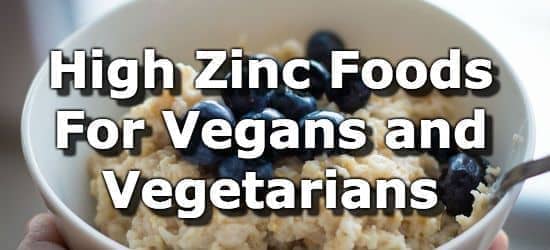 Next ➞
Next ➞
